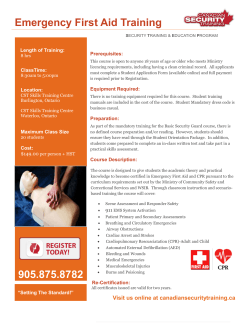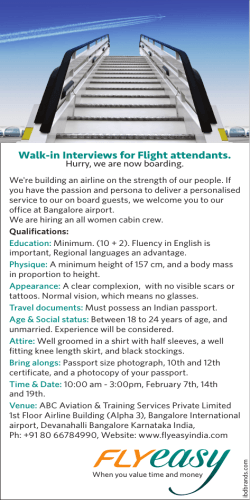
Ready to Join the Mile High Club?
Ready to Join the Mile High Club? A Ra6onal Approach to In-‐Flight Emergencies David S. Bullard, MD, MEd, FACEP, FAWM March 1, 2015 Disclosures • None 2 Objec6ves • • • • • • Recall the prevalence of in-‐flight emergencies List the most common chief complaints Understand how alLtude may affect paLent physiology Become familiar with the contents of in-‐flight medical kits Discuss aircraP diversion, and its ramificaLons Explain the medical-‐legal liability of providing assistance during an in-‐flight emergency 3 Medicine in Austere Environments • Traveling in an aluminum tube at 38,000 feet Physiology to Consider 5 Scope of the Problem • 2.75 billion passengers per year • EsLmate 44,000 in-‐flight medical emergencies worldwide each year • Air Carrier Access Act of 1986 Peterson DC, MarLn-‐Gill C, Guye\e FX, Tobias AZ, et. Al. Outcomes of Medical Emergencies on Commercial Airline Flights. N Engl J Med. 2013;368:2075-‐2083. 6 In-‐Flight Emergencies • January 1, 2008 to October 31, 2010 • 7,198,118 flights in study – 5 airlines (4 domesLc & 1 internaLonal) • EsLmated 744 million passengers during study – About 10% global flight volume for Lme period • Reviewed 11,920 emergency calls – 1 medical emergency / 604 flights – 16 medical emergencies per 1 million passengers Peterson DC, MarLn-‐Gill C, Guye\e FX, Tobias AZ, et. Al. Outcomes of Medical Emergencies on Commercial Airline Flights. N Engl J Med. 2013;368:2075-‐2083. 7 In-‐Flight Emergencies 60 Percentage 50 All In-‐Flight Emergencies 40 Resulted in AircraP Diversion 30 20 10 0 Medical Category Peterson DC, MarLn-‐Gill C, Guye\e FX, Tobias AZ, et. Al. Outcomes of Medical Emergencies on Commercial Airline Flights. N Engl J Med. 2013;368:2075-‐2083. 8 Who provided care? • Physicians 48.1% • Nurses 20.1% • EMS providers 4.4% • Other health care professionals 3.7% • Flight Crew Only 23.7% Peterson DC, MarLn-‐Gill C, Guye\e FX, Tobias AZ, et. Al. Outcomes of Medical Emergencies on Commercial Airline Flights. N Engl J Med. 2013;368:2075-‐2083. 9 AircraH Diversion Rates • 7.3% Overall Flight diversion rate – Physicians 9.4% – Nurses 6.2% – EMS providers 9.3% – Flight Crew only 3.8% Peterson DC, MarLn-‐Gill C, Guye\e FX, Tobias AZ, et. Al. Outcomes of Medical Emergencies on Commercial Airline Flights. N Engl J Med. 2013;368:2075-‐2083. 10 Care from flight personnel • Assess CPR and AED skills of internaLonal airline flight crews • 12 months aPer refresher training • 35 parLcipants – Average of 14 years experience – Average of 9.3 medical emergencies managed (non-‐arrest) – Only 1 parLcipant had performed CPR prior Mahony PH, Griffiths RF, Larsen P, Powell D. RetenLon of knowledge and skills in first aid and resuscitaLon by airline cabin crew. Resuscita3on. 2008;76:413-‐418. 11 Care from flight personnel • Mock Code Results: • 35 parLcipants – 33 failed to use the BVM correctly – 18 performed chest compressions at incorrect site – Only 13 achieved correct compression depth – Only 20 placed the AED pads correctly – Average Lme to first shock was 110 seconds Mahony PH, Griffiths RF, Larsen P, Powell D. RetenLon of knowledge and skills in first aid and resuscitaLon by airline cabin crew. Resuscita3on. 2008;76:413-‐418. 12 13 First Aid Kits Federal AviaLon RegulaLon. 121.803(c)(3). Appendix A. 14 Emergency Medical Kits (EMK) FAA Advisory Circular. 121-‐33B. 1-‐12-‐2006 15 Addi6onal Supplies Not in EMK 16 Haloperidol? 17 Aerospace Medical Associa6on (AsMA) EMK Change Recommenda6ons • • • • • MedicaLon for postpartum bleeding Umbilical cord clamp Urinary catheter Non-‐mercury thermometer Emergency tracheal catheter – (or 14 gauge IV) • • • • • • • • AdrenocorLcal steroid DiureLc “Major” analgesic Beta-‐Blocker SedaLve anLconvulsant AnLemeLc AddiLonal D50 *Removal of lidocaine Thibeault C, Evans A. Emergency medical kit for commercial airlines: an update. Avia3on, Space, and Environmental Medicine. 2007;78(12):1170-‐1171. 18 AED Use • Applied to 137 / 11,920 (1.3%) of paLents – 134 paLents with narraLve records • Syncopy / presyncopy 41% • Chest pain 23.9% • LOC 62.7% • 24 paLents with cardiac arrest – Shock delivered in 5 paLents – Return of spontaneous circulaLon • 1 shocked paLent and 8 paLents without shock Peterson DC, MarLn-‐Gill C, Guye\e FX, Tobias AZ, et. Al. Outcomes of Medical Emergencies on Commercial Airline Flights. N Engl J Med. 2013;368:2075-‐2083. 19 AED Use • 9 paLents with return of spontaneous circulaLon • 8 survived long enough to reach hospital admission Peterson DC, MarLn-‐Gill C, Guye\e FX, Tobias AZ, et. Al. Outcomes of Medical Emergencies on Commercial Airline Flights. N Engl J Med. 2013;368:2075-‐2083. Prac6cal Considera6ons 21 Prac6cal Considera6ons • Where do you put the paLent? • Chief complaint and Resources: – – – – – – Syncope/Near Syncope – monitor, H & P Cardiac – ASA, AED/monitor, O2, NTG, atropine Respiratory – bronchodilator, O2, epinephrine, BVM Allergic –epinephrine, anLhistamine, bronchodilator DiabeLc – D50 Seizure – diazepam? • Diversion? 22 Ground-‐Based Medical Support • MedAire, Inc. • UPMC STAT-‐MD • Mayo Aerospace Medicine 23 24 Flight Diversion • 5 US air carriers who contracted with MedAire • 1132 medical incidents • 13% (145) incidents resulted in diversion – 19% (28) diversions felt to be unnecessary • Physician on board for 449 cases – 16% (70) diversion • No physician on board for 683 cases – 11% (75) diversion DeJohn CA, Véronneau SJ, Wolbrink AM, et al. The evaluaLon of in-‐flight medical care aboard selected US air carriers: 1996-‐1997. Washington DC: Federal AviaLon 25 AdministraLon, Office of AviaLon Medicine, 2000. DOT/FAA report AM-‐0013 Airline Cost of Diversion • RerouLng of passengers • Food and lodging of passengers and crew • Dumping of fuel • “Trickle-‐down” of rerouLng equipment and crews • UlLmate decision for diversion rests with the pilot 26 Liability Issues 27 Interna6onal Law • Which country's laws apply on internaLonal flights? • Laws of the country: – From which the aircraP departed – Toward which it is traveling – Airspace where incident occurred – In which the airline is based • All of the above may all apply 28 Avia6on Medical Assistance Act of 1998 • Liability of Individuals – “An individual shall not be liable for damages in any acLon brought in a Federal or State court arising out of the acts or omissions of the individual in providing or a\empLng to provide assistance in the case of an in-‐flight medical emergency unless the individual, while rendering such assistance, is guilty of gross negligence or willful misconduct.” • Volunteers – must be medically qualified, render care in good faith, and receive no monetary compensaLon to be protected under this Act. • No documented lawsuits United States. Cong. House. Commi\ee on TransportaLon and Infrastructure. AviaLon Medical Assistance Act of 1998. By Elmer G. Shuster. 105 Cong., 2nd sess. H. Rept. 105-‐456. 29 Common Law (US Law) • No obligaLon for a physician to render assistance • The Samaritan is protected against malpracLce liLgaLon, if the following condiLons are met: – – – – – Medically qualified to perform the service Acts voluntarily Acts in good faith No gross negligence or willful misconduct No monetary compensaLon • seat upgrades and travel vouchers do not count as compensaLon 30 Civil Law • Imposes an obligaLon on physicians to render aid Common Law Civil Law Mixed Islamic Law (Sharia) 31 Stevens v. American Airlines • 1997 • Flight from LAX to LHR • Dr. John Stevens – asked to assist a paLent with SOB • Flight diverted to Chicago • Airline thanks Dr. Stevens for his service Dyer C. Doctor demands payment for helping airline passenger. BMJ. 1998;317:701. 32 Liability BoXom-‐Line • Do the right thing • “Rendering Assistance” not “Providing Care” • Never been a lawsuit against a physician acLng as a Good Samaritan 33 Future Trends • Increase in numbers elderly flyers • Need for a registry • Telemedicine • WiFi monitoring 34 Ques6ons? 35 Thank you 36
© Copyright 2025









